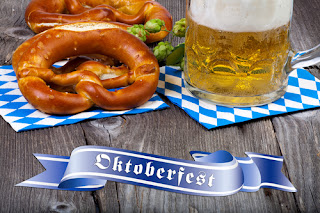For every German-style restaurant and seemingly every micro-brewery in the country, there are American-style takes and versions of Munich’s most famous celebration … Octoberfest Oktoberfest. Let’s look at some of the misconceptions and realities of the 16-day event.
The Festival
 |
| Mmmm … bier! |
each. And it’s not just any fair, it’s the world’s largest. History tells us that the original event was an open invitation for the people of the country to join in celebrating the wedding of Crown Prince Ludwig. I can’t imagine what my wedding anniversary parties will look like in 200 years. The fair is 16 days long, only when it’s not. Oktoberfest officially ends on the first Sunday in October each year, unless that Sunday happens to be October 1 or 2. In those cases, it continues until October 3rd, which is German Unity Day. So, the 16-day fair can be 17 or 18 days long, depending. 2010 marked 200 years of Oktoberfest in Munich. I can’t wait for the 300 year celebration! Enough history and background … on to the bier!
Das Bier
Some Facts
- 6.5 million visitors annually
- There are 14 large and 20 small tents set up. Combined seating capacity is just over 100,000 at any given time. Imagine the south’s largest football stadiums filled with people enjoying beer together! Wait, don’t we already see that anyway?
- A lot of the tents have different reasons: quiet tents, family tents, food, specialty cocktails, traditional dance & music. There is something for everyone!
- There is no ticket to be able to enter. Entry is free! But it is very difficult to get a reservation in the tents – and that’s what you’ll need to do. You have to contact the individual tent hosts to reserve a space. If not, plan to wait in line. For awhile.
- Average liter of beer cost? $13. And you need to tip well if you want a chance for a second one.
- But don’t have too many. There are legions of people who are over-served each year and become “Bierleichen” – roughly translated as ‘beer corpses’.
